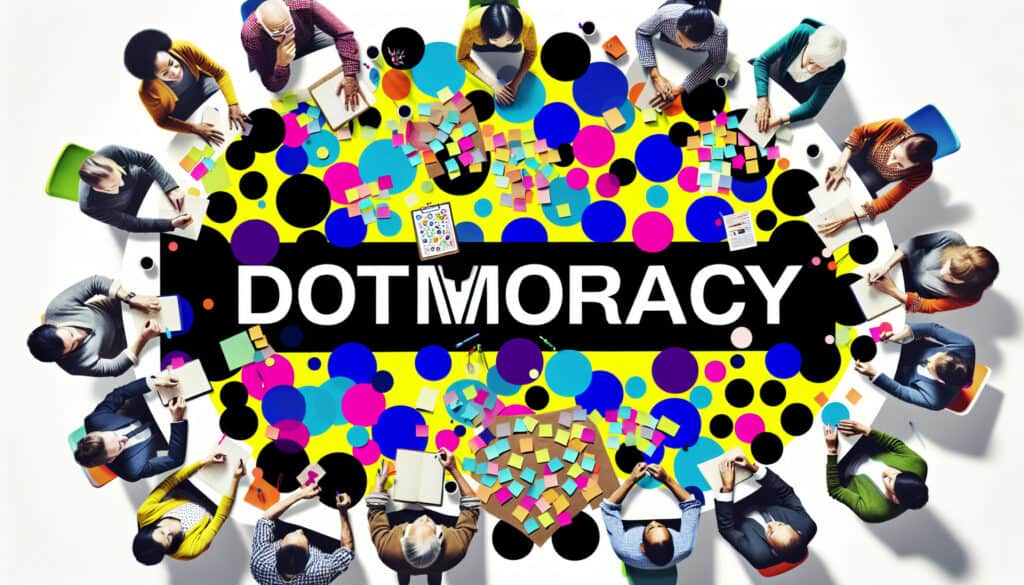A simple facilitation méthode used to help a large group of people prioritize a list of options democratically and visually.
- Méthodologies : Lean Sigma, Fabrication
Dotmocracy

Dotmocracy
- Méthodologie Agile, Amélioration continue, Pensée conceptuelle, Idéation, Innovation, Gestion de projet, Travail d'équipe, User-Centered Design
Objectif :
Comment il est utilisé :
- After a list of ideas is generated and posted on a wall, each participant is given a small number of stickers (dots). They then place their dots on the options they prefer, allowing the group to quickly see which ideas have the most support.
Avantages
- Is a very simple, fast, and transparent way to gauge group consensus; is highly democratic and encourages equal participation; provides a clear visual summary of priorities.
Inconvénients
- Can lead to 'groupthink' where people are influenced by where others have placed their dots; does not allow for discussion or nuance about why an option is preferred.
Catégories :
- Idéation, Résolution de problèmes, Gestion de projet
Idéal pour :
- Quickly and democratically prioritizing a list of ideas in a group setting using stickers or dots.
Dotmocracy is particularly beneficial in environments where collaborative decision-making is fundamental, such as in design thinking workshops, community engagement projects, and corporate brainstorming sessions. Industries such as product development, urban planning, and educational program design frequently utilize this methodology, especially in the conceptual phases where diverse viewpoints are essential to inform the direction of a project. Participants in a Dotmocracy session may include designers, engineers, project stakeholders, and end-users, allowing for a rich cross-section of opinions that can enhance the idea generation process. This method is adaptable across various contexts, from initial idea generation phases to concluding evaluations of proposed solutions, providing a clear framework for collective prioritization. The visual representation of dots on ideas creates an immediate understanding of consensus within the group, making it easy to identify which concepts resonate most strongly with participants. This rapid form of evaluation not only speeds up decision-making but also increases engagement, as everyone has an equal opportunity to weigh in on the options presented. It is particularly useful in settings where time is limited and quick feedback loops are required, allowing teams to pivot based on collective preferences without extensive debates or prolonged discussions. Using tools like sticky notes or digital platforms that simulate this process, organizations can maintain transparency and inclusiveness while ensuring that all voices are heard in the early stages of product design and development.
Principales étapes de cette méthodologie
- Present the list of generated ideas for all participants to see.
- Distribute a limited number of stickers or dots to each participant.
- Allow participants to place their dots on the ideas they prefer.
- Identify the ideas with the highest number of dots as the most supported.
- Discuss the top ideas based on the dot placement for further exploration.
Conseils de pro
- Encourage participants to cluster similar ideas before dot voting, enhancing clarity and reducing redundancy in the options presented.
- Limit the number of dots per participant to avoid skewed results from dominant voices; this fosters more balanced input across the group.
- After voting, facilitate a brief discussion to understand the reasoning behind selections, which can uncover deeper insights into group priorities.
Lire et comparer plusieurs méthodologies, nous recommandons le
> Référentiel méthodologique étendu <
ainsi que plus de 400 autres méthodologies.
Vos commentaires sur cette méthodologie ou des informations supplémentaires sont les bienvenus sur le site web de la Commission européenne. section des commentaires ci-dessous ↓ , ainsi que toute idée ou lien en rapport avec l'ingénierie.
Contexte historique
1960
1980
1983
1990
1995
2000
2010
1950
1980
1980
1986
1994
1995
2000
(si la date est inconnue ou n'est pas pertinente, par exemple "mécanique des fluides", une estimation arrondie de son émergence notable est fournie)














Articles Similaires
Simulation de Monte Carlo
Tests basés sur des modèles
Contrôle des modèles
Recherche sur les méthodes mixtes
À l'épreuve des erreurs (Poka-Yoke)
Test du profil de la mission